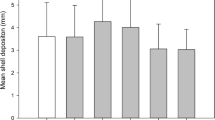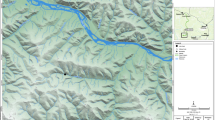Abstract
Acute and chronic estuarine invertebrate and fish toxicity testes were conducted to evaluate possible consequences of measured concentrations of atrazine in estuarine areas. The 96-h LC50 values ranged from 0.094 mg per 1 for copepods to >30 mg per 1 for larvae of eastern oysters. Maximum acceptable toxicant concentrations of >0.08<0.19 mg per 1 and >1.9<3.4 mg per 1 were determined for mysid shrimp and sheepshead minnows, respectively in life cycle and early life cycle testes. The approximate application factor limits in both tests were 0.1–0.2. Use of an application factor of 0.1 with the most sensitive species tested acutely provides a no effect, concentration of approximately 0.009 mg per 1 for estuarine fauna. Therefore, the maximum reported measured concentration of approximately 0.002 mg per 1 atrazine in estuarine areas would not be suspected to adversely impact estuarine fauna.
Similar content being viewed by others
Literature Cited
Anonymous. 1977. Assessing Nonpoint Source Polution: A Detailed Study of a Rural Watershed in the Coastal Plain of Maryland. Chesapeake Bay Center for Environmental Studies. Smithsonian Institution, July 1977. 59 p.
Finney, D. J. 1971. Probit Analysis. Cambridge University Press, London. 333 p.
Hall, J. K., M. Pawlus, and E. R. Higgins 1972. Losses of atrazine in runoff water and soil sediment. J. Environ. Qual., 1:172–176.
Macek, K. J., K. S. Buxton, S. Sauter, S. Gnilka, and J. W. Dean. 1976. Chronic toxicity of atrazine to selected aquatic invertebrates, and fishes, Ecological Research Series, EPA-600/3-76-047, 50 p.
Mount, D. I., and W. A. Brungs. 1967. A simplified dosing apparatus, for fish toxicological studies. Water Research 1:21–29.
Mount, D. I., and C. E. Stephan. 1967. A method for establishing acceptable toxican limits for fishmalathion and the butoxyethanol ester of 2,4-D. Trans. Am. Fish. Soc. 96:185–193.
Newby, L. C., R. A. Kahrs, K. P. Adams, and M. Szolics. 1978. Atraxine residues in the Chesapeake Bay. Presented at the Northeastern Weed Science Society Meeting, New York City, Jan. 4–6, 1978.
Nimmo, D. R., L. H. Bahner, R. A. Rigby, J. M. Sheppard, and A. J. Wilson, Jr. 1977. Mysidopsis bahia: An estuarine species suitable for life-cycle toxicity tests to determine the effects of a pollutant, p. 109–116, In: F. L. Mayer and J. L. Hamelink (eds.). Aquatic Toxicology and Hazard Evaluation, ASTM STP 634, American Society for Testing and Materials, Philadelphia, PA.
Schimmel, S. C., D. J. Hansen, and J. Forester. 1974. Effects of Aroclor 1254 on laboratory-reared embryos and fry of sheepshead minnows (Cyprinodon variegatus). Trans. Am. Fish. Soc. 103:582–586.
Schober, U., and W. Lampert. 1977. Effects of sublethal concentrations of the herbicide Atrazine® on growth and reproduction of Daphnia pulex. Bull. Environ. Contam. Toxicol. 17:269–277.
Shimabukuro, R. H., and H. R. Swanson. 1969. Atrazine metabolism, selectivity, and mode of action. Agric. Food Chem. 17:199–205.
Steel, R. G. D., and J. H. Torrie. 1960. Principles and Procedures of Statistics. McGraw-Hill Book Company, Inc. New York. 481 p.
Stratton, G. W., and C. T. Corke. 1981. Effect of acetone on the toxicity of atrazine towards photosynthesis in Anabaena. J. Environ. Sci. Health B 16: 21–23.
U.S. Environmental Protection Agency. 1975. Methods for acute toxicity tests with fish, macroinvertebrates, and amphibians. Ecological Research Series, EPA-600/3-75-009. 61 p.
Ward, G. S., P. R. Parrish, and R. A. Rigby. 1981. Early life stage toxicity tests with a saltwater fish: Effects of eight chemicals on survival, growth, and development of sheepshead minnows (Cyprinodon variegatus). J. Toxic. Environ. Health 8:225–240.
Williams, D. A. 1971. A test for difference between treatment means when several dose levels are compared with a zero dose control. Biometrics 27:103–117.
Woelke, C. E. 1972. Development of a receiving water quality bioassay, criterion based on the 48-hour Pacific oyster (Crassostrea gigas) embryo. Washington Department of Fisheries, Tech. Rept. No. 9. 93 p.
Wu, T. L. 1981. Atrazine residues in estuarine water and the aerial deposition of atrazine into Rhode River, Maryland. Water Air Soil Pollut. 15:173–184.
Author information
Authors and Affiliations
Rights and permissions
About this article
Cite this article
Ward, G.S., Ballantine, L. Acute and chronic toxicity of atrazine to estuarine fauna. Estuaries 8, 22–27 (1985). https://doi.org/10.2307/1352118
Received:
Accepted:
Issue Date:
DOI: https://doi.org/10.2307/1352118




